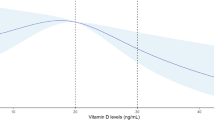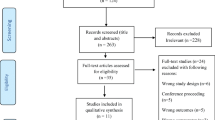Abstract
Gestational diabetes mellitus (GDM), defined as any glucose intolerance with the onset or first recognition during pregnancy, is characterized by rising incidence, fostered by the worldwide increase of pathological nutritional status from young age. Clinical research has intended to identify potential risk factors, suggested improvements in screening strategies, and recommended the combination between promotion of an appropriate lifestyle before and during pregnancy and selected therapeutic approaches. Preventing pathological hyperglycemia could have several benefits, ranging from clinical side (reduction in the risk of adverse perinatal and long-term sequelae) to financial side (cost reduction to healthcare systems). Among risk factors recognized, deficiency in 25-hydroxyvitamin D [25(OH)D], already acknowledged as involved in calcium homeostasis, pathogenesis of cardiovascular, oncological, infective and immunity diseases, could predispose to the development of both type 1 and 2 diabetes, modifying the activity of pancreatic β-cells vitamin D (VD) receptor. In pregnant women, lower 25(OH)D concentrations have been suggested to present an inverse association with maternal glycaemia, insulin resistance, and increased risk of GDM. In spite of growing body of evidence, there is not full agreement on the therapeutic association between GDM based on VD deficiency and 25(OH)D supplementation. In the attempt to bring up-to-date the role of low VD levels on subsequent development of GDM, this narrative review, based on medium–high-quality randomized clinical trials, systematic reviews, and meta-analysis published in last decade, has a twofold purpose: firstly, to elucidate the relationship between maternal VD status and GDM; and secondly, to illuminate the impact of VD supplementation on GDM onset.



Similar content being viewed by others
References
Association AD (2013) Diagnosis and classification of diabetes mellitus. Diabetes Care 36(Suppl 1):S67–S74
Chiefari E, Arcidiacono B, Foti D, Brunetti A (2017) Gestational diabetes mellitus: an updated overview. J Endocrinol Invest. doi:10.1007/s40618-016-0607
Cozzolino M, Serena C, Maggio L et al (2017) Analysis of the main risk factors for gestational diabetes diagnosed with International Association of Diabetes and Pregnancy Study Groups (IADPSG) criteria in multiple pregnancies. J Endocrinol Invest. doi:10.1007/s40618-017-0646-6
Saucedo R, Rico G, Vega G et al (2015) Osteocalcin, under-carboxylated osteocalcin and osteopontin are not associated with gestational diabetes mellitus but are inversely associated with leptin in non-diabetic women. J Endocrinol Invest 38:519–526
Triunfo S, Lanzone A (2016) Potential impact of maternal vitamin D status on obstetric well-being. J Endocrinol Invest 39:37–44
Thorne-Lyman A, Fawzi WW (2012) Vitamin D during pregnancy and maternal, neonatal and infant health outcomes: a systematic review and meta-analysis. Paediatr Perinat Epidemiol 26(S1):75–90
Senti J, Thiele DK, Anderson CM (2012) Maternal vitamin D status as a critical determinant in gestational diabetes. J Obstet Gynecol Neonatal Nurs 41:328–338
Kahn SE, Prigeon RL, McCulloch DK et al (1993) Quantification of the relationship between insulin sensitivity and b-cell function in human subjects. Evidence for a hyperbolic function. Diabetes 42:1663–1672
Kautzky-Willer A, Prager R, Waldhausl W et al (1997) Pronounced insulin resistance and inadequate beta cell secretion characterize lean gestational diabetes during and after pregnancy. Diabetes Care 20:1717–1723
Buchanan TA, **ang AH (2005) Gestational diabetes mellitus. J Clin Invest 115:485–491
Colomiere M, Permezel M, Riley C, Desoye G, Lappas M (2009) Defective insulin signalling in placenta from pregnancies complicated by gestational diabetes mellitus. Eur J Endocrinol 160:567–578
Oztekin O (2007) New insights into the pathophysiology of gestational diabetes mellitus: possible role of human leukocyte antigen-G. Med Hypotheses 69:526–530
Ellard S, Beards F, Allen LL et al (2000) A high prevalence of glucokinase mutations in gestational diabetic subjects selected by clinical criteria. Diabetologia 43:250–253
Haddad JG, Stamp TC (1974) Circulating 25-hydroxyvitamin D in man. Am J Med 57:57–62
Mulligan ML, Felton SK, Riek AE et al (2010) Implications of vitamin D deficiency in pregnancy and lactation. Am J Obstet Gynecol 202(429):e1–e9
Holick MF (2007) Vitamin D deficiency. N Engl J Med 357:266–281
Hypponen E, Laara E, Reunanen A et al (2001) Intake of vitamin D and risk of type 1 diabetes: a birth-cohort study. Lancet 358:1500–1503
Bourlon PM, Billaudel B, Faure-Dussert A (1999) Influence of vitamin D3 deficiency and 1,25 dihydroxyvitamin D3 on de novo insulin biosynthesis in the islets of the rat endocrine pancreas. J Endocrinol 160:87–95
Cade C, Norman AW (1986) Vitamin D3 improves impaired glucose tolerance and insulin secretion in the vitamin D-deficient rat in vivo. Endocrinology 119:84–90
Sahin OA, Goksen D, Ozpinar A et al (2017) Association of vitamin D receptor polymorphisms and type 1 diabetes susceptibility in children: a meta-analysis. Endocr Connect 6(3):159–171
Yu F, Cui LL, Li X et al (2016) The genetic polymorphisms in vitamin D receptor and the risk of type 2 diabetes mellitus: an updated meta-analysis. Asia Pac J Clin Nutr 25(3):614–624
Aslani S, Hossein-Nezhad A, Mirzaei K et al (2011) DR FokI polymorphism and its potential role in the pathogenesis of gestational diabetes mellitus and its complications. Gynecol Endocrinol 27(12):1055–1060
Wang Y, Wang O, Li W et al (2015) Variants in vitamin D binding protein gene are associated with gestational diabetes mellitus. Medicine (Baltimore) 94(40):e1693
Rahmannezhad G, Mashayekhi FJ, Goodarzi MT et al (2016) Association between vitamin D receptor ApaI and TaqI gene polymorphisms and gestational diabetes mellitus in an Iranian pregnant women population. Gene 581(1):43–47
Canadian Diabetes Association (2008) Clinical practice guidelines for the prevention and management of diabetes in Canada. Can J Diabetes 32:S1–S201
International Association of Diabetes And Pregnancy Study Groups Consensus Panel (2010) International association of diabetes and pregnancy study groups recommendations on the diagnosis and classification of hyperglycemia in pregnancy. Diabetes Care 33:676–682
American College of Obstetricians and Gynecologists (2011) Screening and diagnosis of gestational diabetes mellitus. Committee Opinion No. 504. Obstet Gynecol 118:751–753
WHO/NMH/MND/13.2 (2013) Diagnostic criteria and classification of hyperglycaemia first detected in pregnancy. http://www.who.int/diabetes/publications/Hyperglycaemia_In_Pregnancy/en/. Accessed 14 Jan 2017
Coustan DR, Lowe LP, Metzger BE, Dyer AR (2010) The hapo study: paving the way for new diagnostic criteria for GDM. Am J Obstet Gynecol 202:654.e1–654.e6
De-Regil LM, Palacios C, Lombardo LK, Peña-Rosas JP (2016) Vitamin D supplementation for women during pregnancy Issue 1. Art. No.: CD008873
ACOG Committee Opinion No. 495 (2011) Vitamin D: screening and supplementation during pregnancy. Obstet Gynecol 118:197–198
Holick MF (2009) Vitamin D status: measurement, interpretation, and clinical application. Ann Epidemiol 19:73–78
Holick MF (2006) High prevalence of vitamin D inadequacy and implications for health. Mayo Clin Proc 81(3):353–373
Chapuy MC, Preziosi P, Maaner M et al (1997) Prevalence of vitamin D insufficiency in an adult normal population. Osteopor Int 7:439–443
Malabanan AO, Turner AK et al (1998) Severe generalized bone pain and osteoporosis in a premenopausal black female: effect of vitamin D replacement. J Clin Densitometr 1:201–204
Haddow JE, Neveux LM, Palomaki GE et al (2011) The relationship between PTH and 25-hydroxy vitamin D early in pregnancy. Clin Endocrinol (Oxf) 75:309–314
Essley BV, McNanley TJ, Cooper EM et al (2012) Vitamin D insufficiency is prevalent and vitamin D is inversely associated with PTH and calcitriol in pregnant adolescents. J Bone Miner Res 27:177–186
IOM (Institute of Medicine) (2011) Dietary reference intakes for calcium and vitamin D. The National Academies Press, Washington, DC, IOM guidelines for VD supplementation with a special section devoted to pregnancy
Poel YH, Hummel P, Lips P et al (2012) Vitamin D and gestational diabetes: a systematic review and meta-analysis. Eur J Intern Med 23:465–469
Aghajafari F, Nagulesapillai T, Ronksley PE et al (2013) Association between maternal serum 25-hydroxyvitamin D level and pregnancy and neonatal outcomes: systematic review and meta-analysis of observational studies. BMJ 346:f1169
Wei SQ, Qi HP, Luo ZC et al (2013) Maternal vitamin D status and adverse pregnancy outcomes: a systematic review and meta-analysis. J Matern Fetal Neonatal Med 26:889–999
Zhang MX, Pan GT, Guo JF et al (2015) Vitamin D deficiency increases the risk of gestational diabetes mellitus: a meta-analysis of observational studies. Nutrients 7:8366–8375
Lu M, Xu Y, Lv L, Zhang M (2016) Association between vitamin D status and the risk of gestational diabetes mellitus: a meta-analysis. Arch Gynecol Obstet 293:959–966
Karras S, Paschou SA, Kandaraki E et al (2016) Hypovitaminosis D in pregnancy in the Mediterranean region: a systematic review. Eur J Clin Nutr 70:979–986
Simmons D, Devlieger R, van Assche A et al (2017) Effect of physical activity and/or healthy eating on GDM risk: the DALI Lifestyle Study. J Clin Endocrinol Metab 102:903–913
Asemi Z, Karamali M, Esmaillzadeh A (2015) Favorable effects of vitamin D supplementation on pregnancy outcomes in gestational diabetes: a double blind randomized controlled clinical trial. Horm Metab Res 47:565–570
Yap C, Cheung NW, Gunton JE et al (2014) Vitamin D supplementation and the effects on glucose metabolism during pregnancy: a randomized controlled trial. Diabetes Care 37:1837–1844
Hossain N, Kanani FH, Ramzan S et al (2014) Obstetric and neonatal outcomes of maternal vitamin D supplementation: results of an open-label, randomized controlled trial of antenatal vitamin D supplementation in Pakistani women. J Clin Endocrinol Metab 99:2448–2455
Sablok A, Batra A, Thariani K et al (2015) Supplementation of vitamin D in pregnancy and its correlation with feto-maternal outcome. Clin Endocrinol (Oxf) 83:536–541
Asemi Z, Karamali M, Esmaillzadeh A (2014) Effects of calcium-vitamin D co-supplementation on glycaemic control, inflammation and o xidative stress in gestational diabetes: a randomised placebo-controlled trial. Diabetologia 57:1798–806
Yeow TP, Lim SL, Hor CP et al (2015) Impact of vitamin D replacement on markers of glucose metabolism and cardio-metabolic risk in women with former gestational diabetes—a double-blind, randomized controlled trial. PLoS One 10:e0129017
Karamali M, Asemi Z, Ahmadi-Dastjerdi M et al (2015) Calcium plus vitamin D supplementation affects pregnancy outcomes in gestational diabetes: randomized, double-blind, placebo-controlled trial. Public Health Nutr 19:156–163
Pérez-López FR, Pasupuleti V, Mezones-Holguin E et al (2015) Effect of vitamin D supplementation during pregnancy on maternal and neonatal outcomes: a systematic review and meta-analysis of randomized controlled trials. J Steroid Biochem Mol Biol 164:148–155
Palacios C, De-Regil LM, Lombardo LK et al (2015) Vitamin D supplementation during pregnancy: updated meta-analysis on maternal outcomes. Fertil Steril 103(1278–88):e4
Author information
Authors and Affiliations
Corresponding author
Ethics declarations
Conflict of interest
The authors declare that they have no conflict of interest.
Ethical approval
This article does not contain any studies with human participants or animals performed by any of the authors.
Informed consent
No informed consent was necessary for the study.
Rights and permissions
About this article
Cite this article
Triunfo, S., Lanzone, A. & Lindqvist, P.G. Low maternal circulating levels of vitamin D as potential determinant in the development of gestational diabetes mellitus. J Endocrinol Invest 40, 1049–1059 (2017). https://doi.org/10.1007/s40618-017-0696-9
Received:
Accepted:
Published:
Issue Date:
DOI: https://doi.org/10.1007/s40618-017-0696-9




